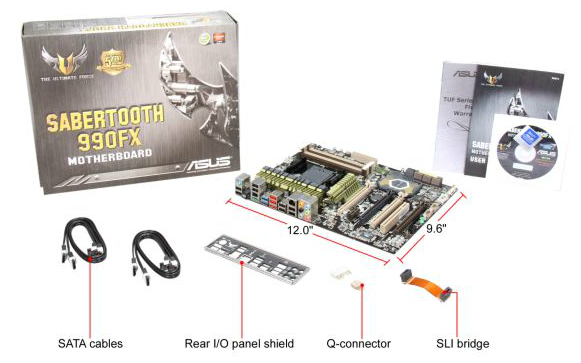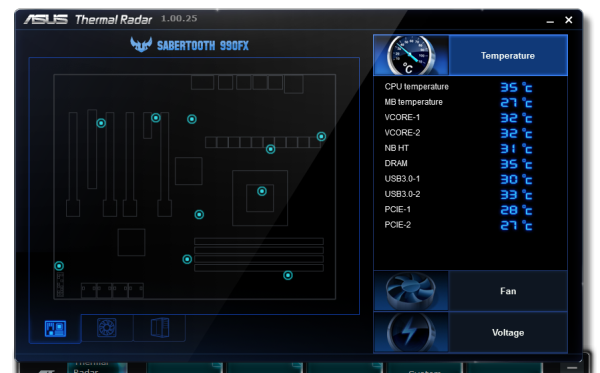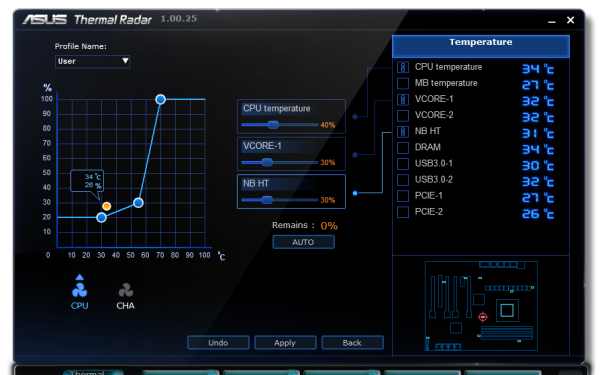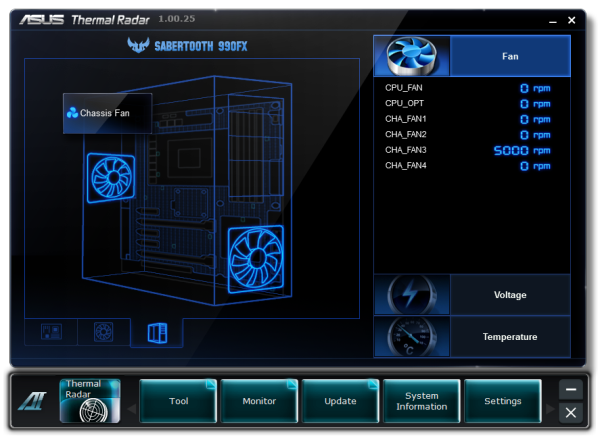990FX Motherboard Roundup with Thuban and Bulldozer – A Second Wind for ASUS, Gigabyte, MSI and Biostar
by Ian Cutress on April 5, 2012 11:00 AM ESTASUS Sabertooth 990FX In The Box
In comparison to the Crosshair V Formula, the Sabertooth does not come with as many goodies in the box. This may be indicative of the price difference (~$45 cheaper for the Sabertooth), and that part of the price of the Sabertooth is due to that five year warranty. In the box, we receive what I would deem the bare minimum for a product of this price:
IO Shield
Driver CD
User Guide
Four SATA Cables (Locking, right angled at one end)
Flexible SLI bridge
ASUS Q-Connector

Image Courtesy of Newegg
Board Features
| ASUS Sabertooth 990FX | |
| Price | Link to Newegg |
| Size | ATX |
| CPU Interface | AM3+ |
| CPU Support | AMD FX/Phenom II/Athlon II/Sempron 100 |
| Chipset | AMD 990FX |
| Base Clock Frequency | 200.66 MHz |
| Core Voltage | Auto, 0.675 V to 2.075 V |
| CPU Clock Multiplier | Auto, 4x to 35x |
| DRAM Voltage | Auto, 1.2 V to 2.5 V |
| DRAM Command Rate | Auto, 1T or 2T |
| Memory Slots |
Four DDR3 DIMM slots supporting up to 32 GB Up to Dual Channel Support for DDR3, 1066-1866 MHz, ECC or Non-ECC |
| Expansion Slots |
3 x PCIe Gen2 x16 (x16/x16 or x16/x8/x8) 1 x PCIe Gen2 x4 1 x PCIe Gen2 x1 1 x PCI |
| Onboard SATA/RAID |
6 x SATA 6 Gbps, Support for RAID 0, 1, 5, 10 2 x SATA 3 Gbps (JMicron JMB362) 1 x Power eSATA 3 Gbps 1 x eSATA 3 Gbps |
| Onboard |
6 x SATA 6 Gbps (Chipset) 2 x SATA 3 Gbps (JMicron JMB362) 6 x Fan Headers 2 x USB 2.0 Headers 1 x USB 3.0 Headers 1 x S/PDIF Output Header 1 x Front Panel Header 1 x COM Port Header 1 x Clear CMOS Header 1 x IEEE1394 Header 1 x MemOK! Button |
| Onboard LAN | Realtek 8111E |
| Onboard Audio | Realtek ALC892 |
| Power Connectors |
1 x 24-pin ATX connector 1 x 8-pin 12V connector |
| Fan Headers |
1 x CPU Fan Header (4-pin) 4 x CHA Fan Headers (one 4-pin, three 3-pin) 1 x OPT Fan Headers (4-pin) |
| IO Panel |
1 x Keyboard/Mouse PS2 Port 1 x Power eSATA 3 Gbps 1 x eSATA 3 Gbps 1 x IEEE1394 Port 1 x Gigabit Ethernet 2 x USB 3.0 10 x USB 2.0 1 x Optical SPDIF Output Audio Outputs |
| BIOS Version | 0901 |
| Warranty Period | 5 Years |
Instead of bleating continuously about that five year warranty, on the board we have a set of six fan connectors, and the SATA ports are bolstered by a SATA 6 Gbps controller in the form of the rarely seen JMicron JMB362. Lacking on the Sabertooth products are the Power/Reset buttons and two-digit debug LED which is unfortunate, plus there is extra space on the back panel for perhaps an extra network controller. The board uses also a Realtek NIC/Audio combination.
Software
ASUS Software revolves around its AI Suite package. This attempts to bring together all the features of the product into one interface, which for the most part is simple enough to use. One downside of the AI Suite software is on the DPC Latency, our audio test. This test performs a deferred procedure call and times how long it takes the system to process it – these calls are queued based on priority. The DP calls done by AI Suite as part of its sensor software have higher priority than audio, thus causing the DPC Latency to increase from ~200 microseconds (sub-500 is a good result), to over 2000 microseconds. Ideally this means that if you are expecting to record audio with an ASUS system, AI Suite should be switched off. I should note that other manufacturers are victims of this also – any vendor that includes sensor software as part of its package and by default causes it to boot with the operating system is liable to these spikes in performance for the DPC Latency test.
With that being said, AI Suite is good at what it does. As this is a Sabertooth product, we get Sabertooth specific features. Instead of the AI Tuner we normally get on an ASUS product, this is replaced by the Thermal Radar:
This integrated fan technology allows the user to associate fans connected on the board to certain temperature sensors. So a chassis fan at the back of the case directed air in or out can be connected to the CPU and VRM sensors (at a ratio determined by the user), and have its speed adjust appropriately using a customized multi-ramp speed profile. If you wanted customizability with your fans, ASUS has got it with their Sabertooth product.
Elsewhere on the AI Suite software is the TurboV Evo option, allowing the user to apply temporary overclocks until the system is restarted, and Digi+ VRM, giving the user control over the limitations of the power delivery on board (applicable to overclocked systems). AI Charger as part of the AI Suite gives extra current to a particular header on the motherboard, allowing it to charge your Apple device (iPod, iPhone or iPad) at a faster rate. Users can also update the BIOS through the AI Suite software.



















57 Comments
View All Comments
mmstick - Thursday, April 5, 2012 - link
The primary problem with AMD FX is that in order to use the full power of the FPU the program needs to be compiled with FMA4 support, else it is only using half of the FPUs, thus making it a quad core. Secondly, many Windows-based programs are compiled with the Intel C+ compiler, so although the FX may support AVX and many other instructions, the compiled program sees it as a non-Intel CPU so it disables those instruction sets, allowing Intel CPUs to be optimized, and AMD CPUs to remain deoptimized. This is what happens when you are up against someone with the most market share, whom has the ability to dictate what instruction sets they want programmers to use. As well, when people say they are going to buy Intel CPUs instead because they claim AMD didn't make a good processor, why do you think they can't be on top of performance? Without R&D budget there isn't much that can be done, and when you face someone who practically owns a monopoly, that makes it even moreso harder to compete.Omoronovo - Thursday, April 5, 2012 - link
The IC++ compiler has not done that since 2010 when they were forced to settle their antitrust dispute with AMD.DigitalFreak - Thursday, April 5, 2012 - link
" This is what happens when you are up against someone with the most market share, whom has the ability to dictate what instruction sets they want programmers to use. As well, when people say they are going to buy Intel CPUs instead because they claim AMD didn't make a good processor, why do you think they can't be on top of performance? Without R&D budget there isn't much that can be done, and when you face someone who practically owns a monopoly, that makes it even moreso harder to compete."Waaaaah. It's always someone else's fault.
anubis44 - Friday, November 9, 2012 - link
"Waaaaah. It's always someone else's fault."Well, sometimes it really IS someone else's fault. If the mafia had it in for you, and cut your brake cables and burnt your house down when you weren't looking, you'd say it's 'someone else's fault' too. Intel's blackmail and threats to suppliers who used AMD processors kinda screwed AMD over just a tad.
That said, I think now that Jim Keller is back at AMD and head of AMD's CPU division, it won't be too long before AMD is seriously back in the game.
Monkeysweat - Thursday, April 5, 2012 - link
I saw them on some of the benchmarks, why didn't you post them along side the AMD benchies for gaming?If we are looking at a roundup of the best of what AMD and it's partners have to offer, I'd like to see what the competing team brings to the table,, just leave em stock and even let the AMD ones get overclocked.
I wouldn't even worry about cherry picking the Intel combos,, just something random.
Beenthere - Thursday, April 5, 2012 - link
AMD has not abandoned the highend CPU market. Their focus may be broadening but that does not mean they will discontinue discrete highend desktop CPUs for at least several years. Eventually everyone except a small group will use APUs as they will deliver the best performance/value proposition. Only extremists will bother with a discrete CPU/GPU with higher power consumption, increased heat and little practical benefit for mainstream users.Articuno - Thursday, April 5, 2012 - link
It's a pretty nice chipset and the lower tier boards are quite cost-effective. Just wish Bulldozer was competitive with Intel, let alone their last gen chips.Mathieu Bourgie - Thursday, April 5, 2012 - link
Thank you for this article Ian.Are there any chance that we'll see a review of the newer FX-6200 CPU or at least have data for it in the CPU bench? Considering that it's 500MHz faster than the model that it's replacing and no major site (or any that I can see) did a review of it, it'd be interesting to see how it performs.
I'm curious to see if it's a valid alternative, in any way, for $170, vs the Intel Core i5-2300 ($180).
I don't expect any miracle for gaming performance, but for workstation workloads (Photoshop, video editing and the like), who knows?
Thanks,
Mathieu
cosminmcm - Thursday, April 5, 2012 - link
There is a review at pcper, a good one. The processor is pretty weak, nothing exciting there. Thuban walks all over it.Mathieu Bourgie - Friday, April 6, 2012 - link
Thanks, I didn't see that.Quite disappointing indeed.
Here's about that Piledriver or Trinity are more competitive.